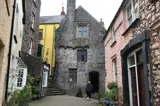Discover
Interesting Historic Sites
From majestic castles to monastic Caldey Island...
South Pembrokeshire has a rich history and is home to several fascinating historic sites which are well worth a visit during your glamping trip.
Carew Castle: This stunning castle dates back to the 12th century and has been well-preserved over the centuries. Explore the impressive towers, keep and gatehouse, take a walk around the picturesque mill pond (and visit the mill itself), and don't forget a bite to eat in The Nest tearoom.
Pembroke Castle: Built in the 11th century, Pembroke Castle is another impressive fortification that played a key role in the history of Wales and was the birthplace of King Henry VII. Whether it's exploring the battlements, climbing to the very top of the keep, exploring the giant map of Pembrokeshire or enjoying a delicious lunch in the castle refectory, it's a great family day out.
St. David's Cathedral: Located in the city of St. David's in the north of the country, this majestic cathedral is the final resting place of St. David, the patron saint of Wales. It is a beautiful example of medieval architecture and has a fascinating history.
Manorbier Castle: Built in the 12th century, Manorbier Castle and is notable for its picturesque location overlooking Manorbier Bay. It has been used as a film location for several movies and TV shows because of it's stunning location.
Caldey Island: This small yet beautiful island lies just 3 miles off Tenby's South Beach, boasting a rich monastic history dating back to the 6th century. Explore the island's tranquil beaches, nature trails, monastery and not forgetting the unmissable Caldey chocolate factory!
Tudor Merchant's House: Nestled away in the picturesque back streets of Tenby you'll find the impressive Tudor Merchant's House, built from lime and sandstone rubble. Step back in time and find out what it was really like to live in the 15th Century!
Lamphey Palace: Take a wander (and a picnic!) around Lamphey’s beautiful palatial grounds; mainly the work of the dynamic Henry de Gower, bishop of St Davids from 1328 to 1347.
These are just a few examples of the wonderful history of our local area - you'll find much more right here on the Visit Pembrokeshire website.







